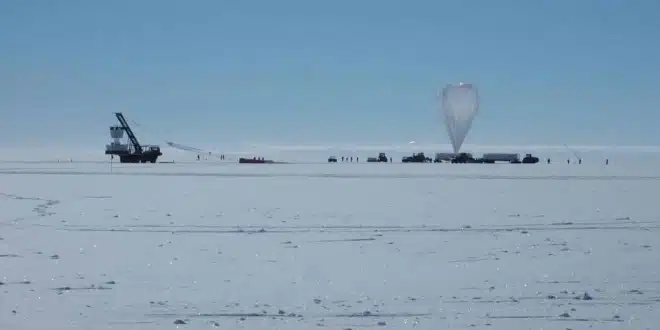A team of international researchers has reported the detection of unexpected radio signals emanating from below Antarctica’s surface. The findings, documented in Physical Review Letters, stem from data gathered by the Antarctic Impulsive Transient Antenna (ANITA), a high-altitude cosmic observatory designed to investigate cosmic phenomena through radio wave detection.
While flying on a balloon platform over the Antarctic ice sheet, ANITA recorded signals that appeared to be traveling upward from beneath the Earth’s surface. These radio pulses originated at steep upward angles, around 30 degrees below the ice’s surface, indicating they had possibly passed through vast sections of the Earth’s crust and mantle before emerging. Under standard scientific models, such behavior is highly improbable.
Typically, high-energy particles like neutrinos that ANITA seeks to detect would enter the Earth from space, interact weakly with matter, and sometimes produce radio emissions as they collide with atoms in the ice. However, the recently detected signals came from the opposite direction—seemingly traveling from below the ground toward the detector.
Stephanie Wissel, a physicist and member of the ANITA collaboration, explained that based on current understanding, such steep-angled radio waves should have been absorbed by the dense rock layers within the Earth, making their detection above the surface improbable. The observed radio pulses thus represent a puzzling anomaly not readily explained by existing models of particle physics or Earth’s geophysical behavior.
ANITA’s Search for Neutrinos and Cosmic Clues
ANITA is engineered to study neutrinos, nearly massless subatomic particles that rarely interact with matter and are produced by intense cosmic sources such as supernovae, gamma-ray bursts, and the Sun. These particles, moving at nearly the speed of light, are believed to carry vital information about high-energy astrophysical processes that occurred across vast distances.
Given their elusive nature, neutrinos are exceptionally hard to detect. Most pass through the Earth without leaving any trace. Instruments like ANITA attempt to observe the rare instances when a neutrino interacts with atoms in ice, producing a detectable burst of radio waves.
Yet, the signals ANITA detected did not align with typical neutrino behavior. If the particles responsible were neutrinos, they would have needed to pass through thousands of kilometers of dense Earth matter without interacting—something that standard models deem highly unlikely. Wissel noted that these signals do not match expected neutrino patterns, further deepening the mystery.
Broader Implications and Continuing Investigations
To validate the nature of these findings, the team compared ANITA’s data with information from other major neutrino observatories: IceCube, also located in Antarctica, and the Pierre Auger Observatory in Argentina. Neither recorded similar anomalies, reinforcing the idea that ANITA’s observations are outliers.
After conducting detailed simulations and evaluating alternative explanations, the researchers determined the signals were indeed anomalous. The scientific community now considers the possibility that these radio waves could point to unknown particles, unconventional interactions, or previously undiscovered physical phenomena.


